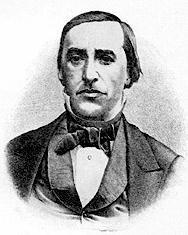Author: George Duffield

Duffield, George, Jr., D.D., son of the Rev. Dr. Duffield, a Presbyterian Minister, was born at Carlisle, Pennsylvania, Sept. 12, 1818, and graduated at Yale College, and at the Union Theological Seminary, New York. From 1840 to 1847 he was a Presbyterian Pastor at Brooklyn; 1847 to 1852, at Bloomfield, New Jersey; 1852 to 1861, at Philadelphia; 1861 to 1865, at Adrian, Michigan; 1865 to 1869, at Galesburg, Illinois; 1869, at Saginaw City, Michigan; and from 1869 at Ann Arbor and Lansing, Michigan. His hymns include;—
1. Blessed Saviour, Thee I love. Jesus only. One of four hymns contributed by him to Darius E. Jones's Temple Melodies, 1851. It is in 6 stanzas of 6 lines. In Dr. Hatfield's Church Hymnbook it is given in 3 s…
Go to person page >Scripture References:
st. 1 = 2 Tim. 2:3
st. 2 = 1 Cor. 16:13
st. 3 = Eph. 6:10-17
st. 4 = Rev. 2:10, 2 Tim. 4:7-8
George Duffield, Jr. (b. Carlisle, PA, 1818; d. Bloomfield, NJ, 1888), was inspired to write this text after hearing the dying words of a Presbyterian colleague, Dudley A. Tyng. Ousted from his own congregation for his strong anti-slavery stance, Tyng preached to large crowds in weekday meetings sponsored by the YMCA. His work spearheaded an evangelical revival in Philadelphia early in 1858. At Tyng's deathbed, caused by a farm accident in which he lost an arm, Duffield and others asked if he had any final message. Tyng replied, 'Tell them to stand up for Jesus!" At Tyng's memorial service on April 25, 1858, Duffield preached on Ephesians 6:14 and concluded his sermon by reading his new hymn text, "Stand Up, Stand Up for Jesus." Several lines in that original text referred to Tyng's words and ministry. The six-stanza text was first distributed in leaflet form and then was published in The Church Psalmist (1859). The Psalter Hymnal follows the custom of most hymnals of including the original stanzas 1, 3, 4, and 6 with updated language.
The challenge of "Stand Up for Jesus" is proclaimed through the military metaphors Paul uses in Ephesians 6:10-18. Although some decry the warlike imagery, the spiritual battle that Christians must fight is very real. Christ's victory is assured even if we do not always move "from victory unto victory" in our earthly lives.
A graduate of Yale College and Union Theological Seminary, Duffield served eight Presbyterian churches in New York, New Jersey, Pennsylvania, Illinois, and Michigan. He was a regent for the University of Michigan for seven years, served as editor of the Presbyterian paper Christian Observer; and promoted evangelistic work with his personal wealth. Duffield's interest in hymnody influenced his son, Samuel W. Duffield, to publish English Hymns, Their Authors and History (1886).
Liturgical Use:
Profession of faith; adult baptism; ordination and commissioning services; various other times of worship.
--Psalter Hymnal Handbook
Notes
Scripture References:
st. 1 = 2 Tim. 2:3
st. 2 = 1 Cor. 16:13
st. 3 = Eph. 6:10-17
st. 4 = Rev. 2:10, 2 Tim. 4:7-8
George Duffield, Jr. (b. Carlisle, PA, 1818; d. Bloomfield, NJ, 1888), was inspired to write this text after hearing the dying words of a Presbyterian colleague, Dudley A. Tyng. Ousted from his own congregation for his strong anti-slavery stance, Tyng preached to large crowds in weekday meetings sponsored by the YMCA. His work spearheaded an evangelical revival in Philadelphia early in 1858. At Tyng's deathbed, caused by a farm accident in which he lost an arm, Duffield and others asked if he had any final message. Tyng replied, 'Tell them to stand up for Jesus!" At Tyng's memorial service on April 25, 1858, Duffield preached on Ephesians 6:14 and concluded his sermon by reading his new hymn text, "Stand Up, Stand Up for Jesus." Several lines in that original text referred to Tyng's words and ministry. The six-stanza text was first distributed in leaflet form and then was published in The Church Psalmist (1859). The Psalter Hymnal follows the custom of most hymnals of including the original stanzas 1, 3, 4, and 6 with updated language.
The challenge of "Stand Up for Jesus" is proclaimed through the military metaphors Paul uses in Ephesians 6:10-18. Although some decry the warlike imagery, the spiritual battle that Christians must fight is very real. Christ's victory is assured even if we do not always move "from victory unto victory" in our earthly lives.
A graduate of Yale College and Union Theological Seminary, Duffield served eight Presbyterian churches in New York, New Jersey, Pennsylvania, Illinois, and Michigan. He was a regent for the University of Michigan for seven years, served as editor of the Presbyterian paper Christian Observer; and promoted evangelistic work with his personal wealth. Duffield's interest in hymnody influenced his son, Samuel W. Duffield, to publish English Hymns, Their Authors and History (1886).
Liturgical Use:
Profession of faith; adult baptism; ordination and commissioning services; various other times of worship.
--Psalter Hymnal Handbook
Hymnary Pro Subscribers
Access
an additional article
on the Canterbury Dictionary of Hymnology:
Hymnary Pro subscribers have full access to the Canterbury Dictionary of Hymnology.
Subscribe now


 My Starred Hymns
My Starred Hymns







